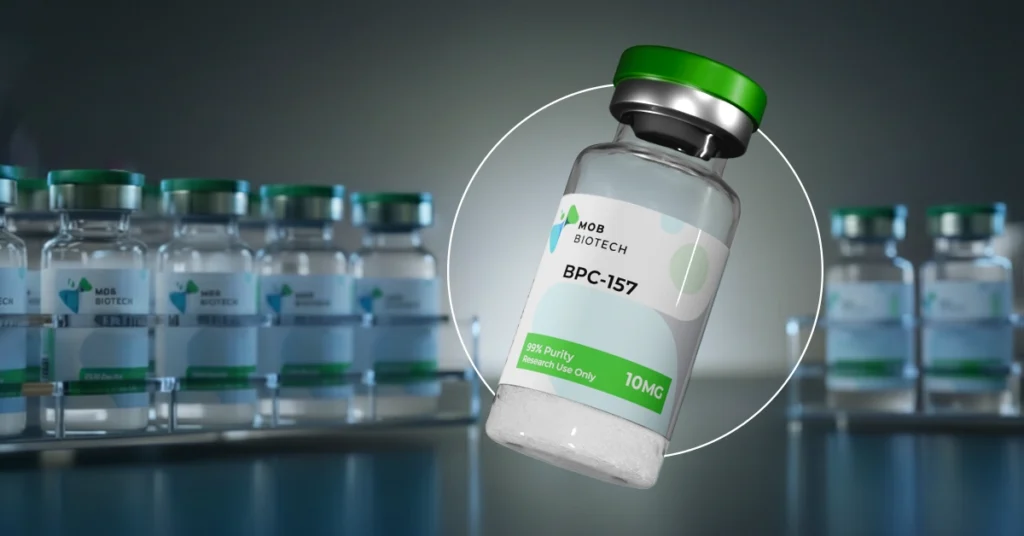Why serious researchers don’t leave this one out.
Let’s be honest: in this space, not every product deserves a place on your bench. Some make a splash, get attention, then disappear just as fast. But BPC-157? That one never left.
If you’ve been circling it, waiting for a sign—it’s already in your hands. Because when thousands of researchers keep coming back to the same compound across categories like soft tissue repair, inflammation control, and angiogenesis, there’s usually a reason. Actually—there are several.
First, What Is BPC-157?
BPC-157 (Body Protective Compound-157) is a pentadecapeptide derived from a protein found in gastric juice. It’s been studied for its cytoprotective and regenerative potential in a wide range of in-vitro and in-vivo models. In plain terms: it’s gained a reputation for supporting biological processes related to recovery, inflammation modulation, and cellular protection.
Its unique positioning in the peptide research space lies in how multi-pathway it is. This isn’t a narrow-focus compound—it interacts with vascular, neural, muscular, and gastrointestinal systems, making it one of the most versatile compounds in the regenerative research category.
And yet, it’s still underutilized by many labs. Why?
Because With BPC-157, You Don’t See Flash—You See Function
There’s no overhyped launch campaign, no gimmicky spin. What you get with BPC-157 is data. Clean mechanisms. Repeatable outcomes. That’s the kind of thing the right researchers notice.
Here’s what current research models are exploring:
- Angiogenesis & Blood Vessel Formation
Studies point to accelerated angiogenic repair, meaning better vascular support in tissue healing models. - Muscle, Tendon, and Ligament Regeneration
BPC-157 has shown promise in injury recovery models where mechanical stress is involved, particularly for musculoskeletal systems. - Inflammation Regulation
Models show BPC-157 interacting with nitric oxide systems and other inflammatory pathways—potentially offering modulation effects. - Neuroprotective Potential
There are ongoing investigations into its interaction with dopamine and serotonin systems, showing interest in neurological support applications.
Let’s be clear: none of this is about miracle molecules. This is about repeatable mechanisms that researchers trust. That’s where BPC-157 consistently holds ground.
Why Researchers Stack BPC-157 With TB-500
Ask any high-volume lab what shows up together on their supply orders. It’s no coincidence that BPC-157 and TB-500 often arrive in the same box.
Where BPC-157 works on a cellular level to support microvascular healing and reduce oxidative stress, TB-500 (Thymosin Beta-4 fragment) is being studied for its ability to regulate actin and support cell migration and remodeling.
Together, researchers are exploring:
- Synergistic wound healing outcomes
- Accelerated tissue recovery
- Broader systemic repair signaling
Some call it the “repair protocol duo.” We just call it smart stacking.
Let’s not pretend reputation doesn’t matter
Let’s not pretend reputation doesn’t matter. You see a lab’s order history, their stacks, and their frequency—and patterns emerge.
BPC-157 is on the list of researchers who know what they’re doing.
There’s a reason it keeps showing up in multi-category protocols and long-term research pipelines. When outcomes matter, and you don’t have time to gamble on unreliable compounds, this is one of the few that gets the nod from the veterans.
Are new researchers missing out? Possibly.
Are the experienced ones sharing notes? Quietly.
But they’re all pointing in the same direction: BPC-157 doesn’t just belong. It delivers.
It’s Not Just About Supply
Let’s talk facts: you don’t want to waste your time.
Wasted protocols. Unreliable batches. Delays.
They cost you. Not just time—but trust in your data.
That’s why sourcing CoA-backed BPC-157, batch-tested and US-fulfilled, should be the non-negotiable standard.
Here’s what to verify before adding BPC-157 to any protocol:
- ✅ Certificate of Analysis (CoA) verifying purity and identity
- ✅ HPLC and Mass Spec data provided and consistent
- ✅ Clear lot tracking and storage conditions
- ✅ Verified supply chain with strict sourcing
- ✅ Transparent communication from the supplier
At MOB Biotech, we built our operation to exceed those standards—not meet them. You’ll see the difference in your first shipment.
So Why Do Some Labs Still Skip It?
It’s a fair question.
Some avoid BPC-157 because it’s not trendy. Others think they’ve got their regeneration protocols dialed in. Some are skeptical of broad-function peptides.
But the ones who’ve stayed ahead? They tested it. Re-tested it.
And then built protocols around it.
If you’re still on the fence, that’s fine. But in this field, missing the right tool can cost you more than the time it takes to evaluate it.
Where Does It Fit?
BPC-157 has been integrated into studies across multiple verticals. It’s not limited to one lane, which makes it particularly valuable in multi-target protocols.
Researchers have used it to explore:
- Tissue damage models (tendons, ligaments, gut lining)
- Neurological inflammation and protection
- Stress-induced damage and repair signaling
- Gut-brain axis interactions
- Systemic response recovery
It’s flexible. It’s clean. And when sourced right—it’s consistent.
Final Word: BPC-157 Is the One People Come Back To
Not everything sticks in this industry. But BPC-157 isn’t going anywhere.
Because serious researchers don’t want hype—they want control, clarity, and confidence in what they’re working with.
That’s what this peptide offers. That’s why it’s stayed relevant.
And that’s why it might be worth revisiting—before your next order is already locked.
Want verified, batch-tested BPC-157?
🧬 US-Based. CoA-Backed. Rewards on every purchase.
👉 Explore BPC-157 at MOB Biotech

